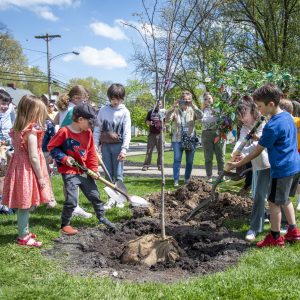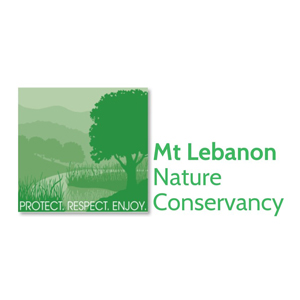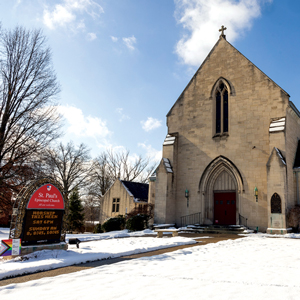preserving America’s untold stories
From the El Morro carvings to North Dakota badlands
to the Whitehouse gardens to the Great Lakes waters…
No, this is not some long-forgotten verse of This Land Is Your Land—but rather, a month in the life of Peter Argentine, Mayfair Drive resident and founder of Argentine Productions, who creates documentaries and informational media tailored to museums, parks and other visitor experiences all over the United States.
In April, Argentine Productions brought home a Special Jury Award, the most prestigious award next to Best of Festival, at the Houston International Film Festival for Prairie River Home, which showcases the biodiversity of the Niobrara National Scenic River through stunning footage of the landscape and wildlife. Argentine Productions also won a Platinum Remi Award for Peale’s Museum and a Gold Remi Award for Fugitive Slave Trials. Both projects were filmed at Independence Hall in Philadelphia and will premiere with the new visitor center this month.
“It’s definitely a job where it helps to know a little about a lot,” says Argentine. “Each time you go to a place in this job, you are learning something new. Earlier, I was working on the script for the John Day Fossil Beds—I had a geology class in college, so I knew about fossils! But it’s also really hard switching from fossils in Oregon to Valley Forge, Pennsylvania, in one hour.”
Luckily, he doesn’t do it alone. Two of his sons work for Argentine Productions—Per is a producer/editor and Erik is associate producer/writer—and his other son and daughter, Anthony and Anna, help with storyboarding and production when they can. All four of them are Mt. Lebanon graduates.

“The really great part is being able to travel together to these spectacular places, and we often see and experience things that a public visitor might never see … it’s nice to share that with [my kids,]” says Argentine. “I also love to see the different creative thoughts that they bring to various stages of a project, and to have observed their skills develop.”
Argentine also employs a team of talented professionals and freelancers, some based as far away as Colorado, and he operates his business from his home, where he lives with is wife, Helene.
“It’s helpful that we have a good talent base [here in Pittsburgh], and it was a great place to raise a family … We had a large office space, but because everything is on the internet now, we had no clients visiting us. So we just added an office to the house.” says Argentine.
Argentine’s career started in public broadcasting, even though when he graduated from Cornell University with a degree in anthropology, he knew that he wanted to pursue anthropological documentary. “For my senior project, I did a photo essay on long-haul truckers and a film on the Oneida Indian Nation. I knew I wanted to continue to have a positive impact on the world, be creative and be outdoors,” says Argentine.
He remembers going to a presentation by MIT’s Media Lab in the ’80s, and they were predicting that broadcast would break up into niche categories by the end of the decade. In Argentine’s opinion, that did not really start happening until the past decade (“Now my Swedish wife can say ‘Let’s watch curling,’ and we can actually find it!”), but he knew back then that his calling was to produce film that was more historical than anything that could be found on cable television.
After spending some time working locally at PBS and WQED, where he was honored to work with Fred Rogers in the last years of his show, Argentine decided to start his own company in 1993, and he quickly realized that producing films for museums and parks was the right fit for him.

“I started to see that museums were the last bastion of people who really care that the facts are right, that there are multiple viewpoints being presented, and that people are being educated or engaged emotionally in some way,” says Argentine.
Now, decades later, Argentine has developed an enormous portfolio of projects from all over the United States. To get a true sense of the variety of his work, one needs only to look at some of his most recent projects:
Valley Forge National Historic Park, Pennsylvania (Revolutionary War encampment 1777-78) “We are in production on a new orientation video for the visitor center and five web videos that were more specific to the camp followers—the women, freemen of color, the slaves, doctors and nurses and two Native American tribes who were present … I like working with the park service, because their focus word is ‘interpretation.’ They want to engage people so that there is a learning moment. For example, Valley Forge isn’t just about who was where when. It’s about the lessons that can apply to life today about surviving hardship, endurance and strength of character when an outcome is not certain.”
John Day Fossil Beds National Monument, Oregon (Eocene and Miocene Era fossil site) “We will be working on one main film and six short videos … John Day is just such a spectacular place in Oregon. It tells the story of changing climate over time and how it affected the animals and how they evolved.”
Independence National Historical Park, Philadelphia, Pennsylvania (Independence Hall, the Liberty Bell, Franklin Court and more) “At Independence Park, we did a reenactment of the fugitive slave trials, which were a result of the Fugitive Slave Act. They actually had hearings for it on the second floor of Independence Hall. How ironic is that? We depicted three different hearings—for the first one, the man went free, the second, his freedom was bought, and the third was a pregnant woman and child, who were sent back into slavery. It was a horrible story that I had never heard about before. … another [film for Independence Historical Park] was an independent short on Charles Willson Peale, whose museum was on the second floor of Independence Hall, and he was almost more passionate about his museum than he was about his paintings.”

Cabrillo National Monument, San Diego, California (Historic Old Point Loma Lighthouse and Fort Rosecrans) “We conducted 20 oral history interviews with WWII veterans and five with lighthouse keeper descendants … the veteran interviews were really powerful. Some of these men were 90, 100 years old. Hearing their stories, the resilience, what they were facing—it makes you realize our problems are all little ones.”
Marshall Gold State Historic Park, Coloma, California (Location where James W. Marshall discovered gold in 1848, sparking the California Gold Rush) “At the exhibit, we projected a big map onto a screen that was made to look like a stretched buffalo skin. Some of it was interactive. This project was cool.”
Daniel Boone Wilderness Trail, Gate City, Virginia (Trail blazed by Daniel Boone in 1775 connecting settlers to the western frontier) “We completed a video and some installation videos. The exhibit has some interactive elements. For example, you walk by a fire place and hear people talking about how they are happy to be by the fire rather than out in the wilderness.”
Gettysburg National Military Park, Pennsylvania (The Battle of Gettysburg, 1863) “We completed ten social media videos for the Gettysburg Foundation last year [The “Why Gettysburg” series] … sometimes it can be challenging shooting in parks, because they don’t actually look how they did in history. But Gettysburg was easier because they are really trying to restore the landscape. Each video was centered around a question, and was meant to target [younger generations] and women. For example, one of my favorites told the story of the statue of a pregnant woman in Gettysburg Cemetery … Some of the videos got more than 20,000 views in the first month.”
El Morro National Monument, Cibola County, New Mexico (Desert campsite and watering hole featuring the carvings of centuries of travelers) “Often we are trying to show the public things they can’t see, or are trying to create a tour for accessibility purposes … at El Morro, the path is on top of a cliff, so it’s pretty steep to get up there, and if the weather is bad, no one can get up there at all. The video gives a chance for more people to see the site.”
“I think one of the most important things I have learned is to treat people well, and I’m glad that we seem to have built a reputation of being good to work with,” says Argentine. “I think another thing I learned when I worked with Fred Rogers is that the process is just as important as the end product … if you use the Golden Rule [and develop a process], it’s a positive experience for everyone.”
Argentine also takes inspiration from fellow filmmakers such as Werner Herzog, because he believes that Herzog is a master of the “teaching moment,” by effectively getting to the core questions or themes in his documentaries. As could be expected, Argentine enjoys watching documentaries and informative television whenever he has the time, including shows such as 60 minutes and the PBS specials Frontline and Nova. His guilty pleasure is Timeless, an NBC drama where the characters travel through time and visit key moments in history to help save the world.
To students who are interested in historical filmmaking, Argentine’s first piece of advice is to educate yourself thoroughly and be clear on your goals, because there are many paths to take in the filmmaking industry. He also recognizes the need to be humble, particularly in the beginning. But he particularly emphasized a piece of advice from his father: “A job worth doing is a job worth doing well,” which has helped shape the way he approaches his career.
“Working on the Charles Willson Peale piece … one of his slogans was ‘an educated, enlightened citizenry is essential to sustaining the republic,’ and that’s really almost the motto of our company,” says Argentine. “Part of our mission is to educate people about the value of our diverse natural history and to educate people about our country’s incredible history and many untold stories.”
Related stories:
Finish Lines, January/February 2015 (Q&A with Peter Argentine)
Ones to Watch, October 2014 (Peter Argentine appointed to USPS Citizen Stamp Advisory Committee)
Visit Argentine Productions’ website or Facebook page for more information.





